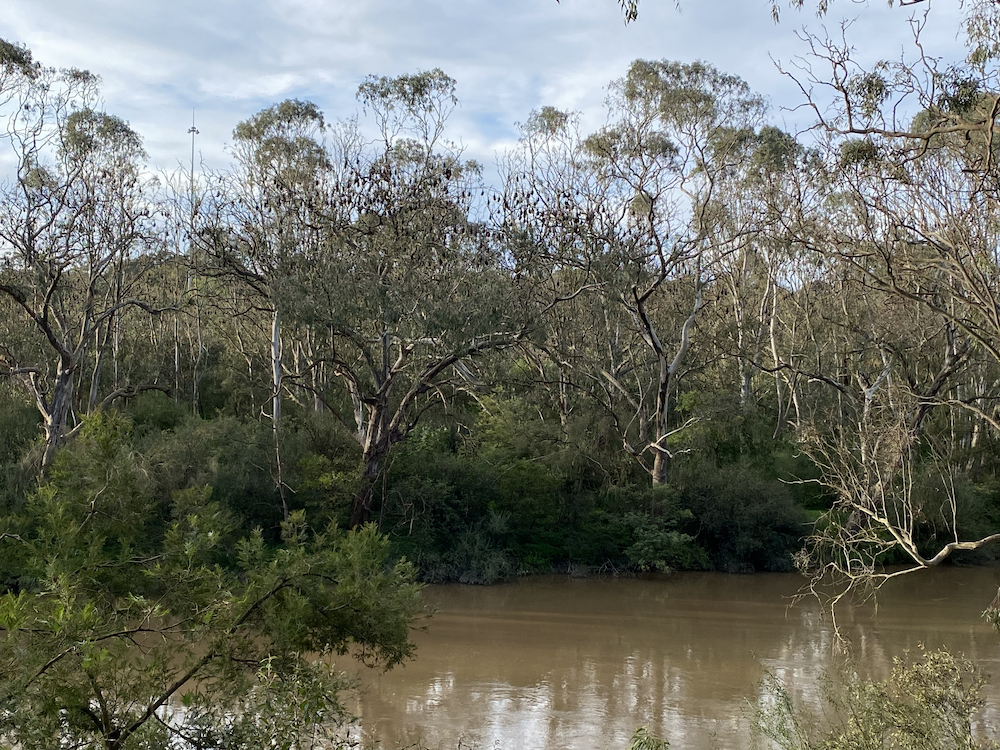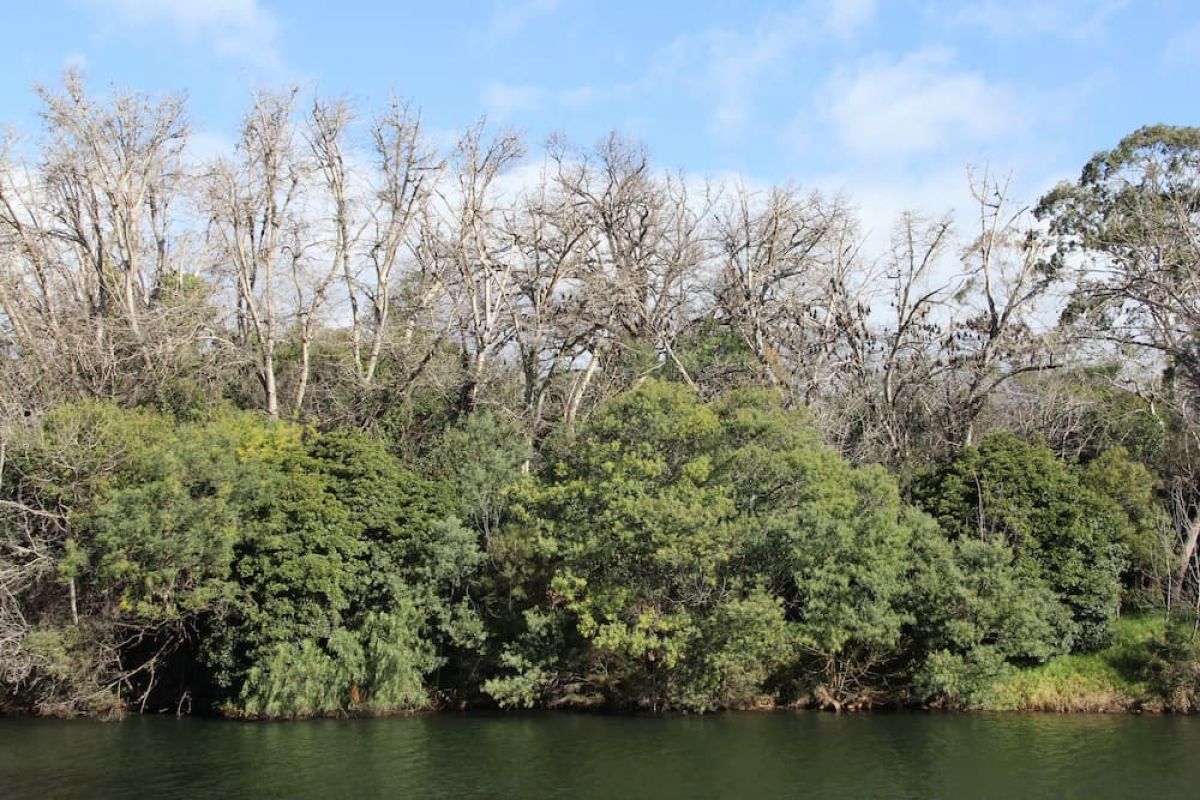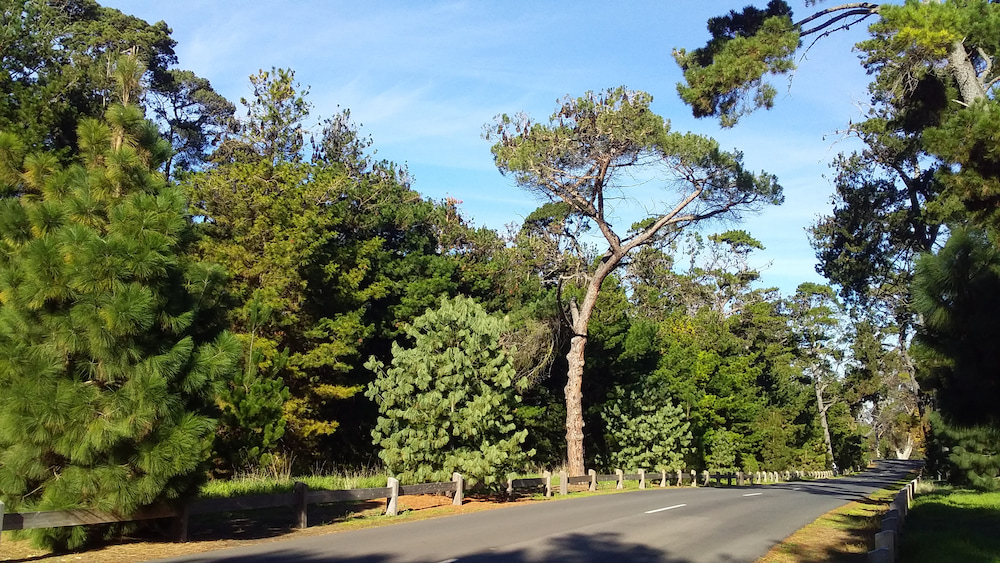Flying-foxes are found across Victoria in a wide variety of habitats.
Flying-fox camps may be used permanently, seasonally or only sometimes. The size and occupancy of a camp may depend on how much food can be found in the surrounding landscape. Flying-fox numbers can increase dramatically when food resources are abundant, for example during a large flowering event in native forest. If food resources decline, flying-foxes may move on in search of more food.
How flying-foxes choose roost sites is not well understood. Often roost sites are close to water and contain tall trees and a dense understorey, but not always. Flying-foxes sometimes roost in native vegetation such as streamside trees, bushland, rainforests or mangroves. They also roost in exotic trees such as elms, pines or peppercorn trees.
Why do flying-foxes find towns and cities attractive?
Flying-foxes increasingly roost in urban areas, such as town parks or botanic gardens.
Urban areas can contain reliable food for flying-foxes all year round. They can support a diversity of non-local and exotic plants grown in parks, roadsides and gardens. Warmer temperatures and artificial watering may also make cities more attractive and productive.
Did you know?
Flying-foxes are constantly moving between camps! The composition of a flying-fox camp is very fluid – every day, about 18% of the animals will likely move on to other areas.
While some flying-foxes may stay in one camp for longer periods, it's thought most visits are short-term and don't last more than a week.
Around Melbourne
Prior to 2003, Melbourne’s Grey-headed Flying-foxes roosted in the Royal Botanic Gardens. The camp was relocated due to impacts on heritage-listed vegetation at the gardens. Flying-foxes settled at Yarra Bend Park in Kew, 5 km north-east of central Melbourne. Yarra Bend Park is a large reserve transected by the Yarra River, supporting expansive woodland vegetation dominated by River Red-gums.
Flying-foxes roost in a bushland corridor surrounded by residential development to the east, the Yarra Bend Golf Course to the west and the Eastern Freeway to the north. The camp footprint has been revegetated to improve habitat values for Grey-headed Flying-foxes.
The Yarra Bend camp is a nationally important camp. It regularly supports more than 10,000 Grey-headed Flying-foxes and numbers can exceed 30,000 during summer. In winter, the numbers decline, but several thousand flying-foxes usually remain.
There are excellent views of flying-foxes from Yarra Boulevard, looking out over the camp and towards the city skyline.
More information on flying-fox management following the relocation is available from our Customer Contact Centre by phoning 136 186.
Doveton
Doveton in southeast Melbourne has been home to a permanent camp of Grey-headed Flying-foxes since 2013. The camp is located along Dandenong Creek and adjacent wetlands, scrub, woodland, open space and residential areas. Flying-foxes roost in both native trees and exotic trees, including River Red-gum, paperbark and willow.
The Doveton camp tends to support several thousand flying-foxes. In summer, numbers increase and the camp expands across the wetlands. Flying-fox numbers at Doveton decline over the winter months.
Werribee
Werribee South in southwest Melbourne has been home to a semi-permanent camp of Grey-headed Flying-foxes since 2015. The flying-foxes have alternated between roosting on the grounds of Werribee Park and nearby private property. The park contains Werribee Mansion, heritage-listed trees and formal gardens and hosts a series of major events. Flying-foxes roost mostly in pine as well as other species near the mansion, not far from the Werribee River.
The Werribee camp may be vacant sometimes, especially in cooler months. The camp expands in summer and may support several hundred flying-foxes.

Flying-foxes roosting at the Yarra Bend camp, Wurundjeri Country.
What is a nationally important camp?
Grey-headed Flying-foxes are listed as vulnerable under the Commonwealth Environment Protection and Biodiversity Conservation Act 1999 (EPBC Act). Nationally important camps may contain an ecologically significant proportion of the population.
A camp is considered nationally important if it has contained ≥10,000 Grey-headed Flying-foxes for more than 1 year in the last 10 years or has been occupied by more than 2,500 Grey-headed Flying-foxes permanently or seasonally every year for the last 10 years.
A flying-fox camp’s status may impact whether actions are likely to have a significant impact on the species under the EPBC Act, and require referral to the Minister.
Eastern Victoria
Grey-headed Flying-foxes established a seasonal camp in Bairnsdale in 2002. The camp is located on the banks of the Mitchell River, in an area with a ‘jungle’ like understorey of native and exotic plants with emergent trees such as White Poplars. Flying-foxes roost throughout this area and on occasions the camp expands into vegetation in the parklands further along the river.
Several thousand flying-foxes usually roost at the Bairnsdale camp, with more arriving in spring and summer. Since 2020, the camp has been used permanently. The Bairnsdale camp is nationally important and regularly contains more than 10,000 flying-foxes.
Sale
Grey-headed Flying-foxes established a seasonal camp on an island in Sale's Lake Guthridge in 2002. On occasions the camp has expanded into vegetation in the surrounding parklands, including the Lake Guyatt Reserve and Sale Botanic Gardens. Flying-foxes roost in a range of native and exotic vegetation in the parklands, such as River Red-gum, paperbark and willow.
Flying-foxes use the Sale camp seasonally, but in some years they will stay for longer periods. During winter, the camp may be empty, or only contain about 200 individuals. In summer the population usually increases, sometimes to more than 30,000 flying-foxes. The Sale camp meets the criteria for a nationally important camp.
Maffra
Grey-headed Flying-foxes established a seasonal camp on the Macalister River near Maffra in 2014. Flying-foxes roost here in a mix of vegetation including native River Red-gums and exotic tree species. During summer, there are usually at least 1,000 flying-foxes roosting at the Maffra camp. Numbers can influx to 20,000 or more during large flowering events.
Traralgon
Grey-headed Flying-foxes established a seasonal camp within Victory Park at Traralgon in 2013. The Traralgon Creek meanders through the park which also features play-spaces, walking paths and the local Scout Hall. Flying-foxes roost here in a mix of large native and exotic tree species.
Flying-foxes arrive in Traralgon in most years, usually in the warmer months and numbers vary from a few hundred to several thousand.
Karbeethong
Grey-headed Flying-foxes established a seasonal camp at Karbeethong near Mallacoota in 2003. Flying-foxes roost here in a mix of native species including paperbarks, lilly pilly, pittosporum and emergent eucalypts.
In late summer and autumn, when Red Bloodwood and Angophora species are flowering in the surrounding forests, thousands of flying-foxes gather in Karbeethong. During bountiful flowering events, numbers at the camp can swell to more than 50,000.
The Karbeethong camp meets the criteria for a nationally important camp.





Western Victoria
Geelong
Grey-headed Flying-foxes established a camp in 2003 in Eastern Park, Geelong. Eastern Park is a large heritage-listed park situated between Corio Bay and Geelong’s Central Business District. It contains the Geelong Botanic Gardens, the East Geelong Golf Club and various garden features including heritage-listed trees.
Flying-foxes roost just north of the Golf Club and along the Eastern Park Circuit, mostly in Radiata Pines and sometimes in trees within the Golf Club.
The Geelong flying-fox camp is permanent and considered nationally important. There are usually several thousand flying-foxes present at the camp. More than 10,000 individuals are regularly seen during summer.
Flying-foxes may be disturbed at the Geelong camp due to the camp’s proximity to the road. Admire flying-foxes from a distance and avoid loud noises to limit disturbance to the camp.
Colac
Colac’s Botanic Gardens is a heritage-listed garden on the southern bank of Lake Colac. In 2016, Grey-headed Flying-foxes started to roost in the gardens. The flying-foxes started using the gardens intermittently, but sometimes stay for longer periods. The flying-foxes roost in planted trees within the gardens including elms and oaks. Some have been significantly impacted including some individually significant heritage-listed trees. Colac Otway Shire has undertaken a management program to encourage the flying-foxes to move to a more robust site within the gardens.
Flying-fox numbers at the Colac camp fluctuate from several hundred to more than 9,000. The camp tends to be larger in summer.
A camp of Grey-headed Flying-foxes have roosted in Warrnambool’s Botanic Gardens since at least 2013. Initially flying-foxes would stay here seasonally, but they have remained year-round since 2018. The flying-foxes roost in a range of exotic trees in the gardens, including English Oak and Moreton Bay Fig.
There are usually fewer than 1,000 flying-foxes present at the Warrnambool camp, with numbers tending to be higher in summer and autumn compared to winter and spring.

Flying-foxes roosting at Eastern Park in Geelong, Wadawurrung Country. Credit Grant Baverstock
Northern Victoria
Bendigo
Rosalind Park is a heritage-listed European garden on Dja Dja Wurrung Country in central Bendigo. Rosalind Park includes a fenced fernery, with lush vegetation and large trees including oaks, elms and eucalypts. Grey-headed Flying-foxes appeared in Rosalind Park in central Bendigo in 2010.
The Bendigo camp has since become permanent and is considered nationally important. Flying-foxes primarily roost in the fernery and nearby European trees. Bats hold cultural value for Dja Dja Wurrung people across Country, with teachings and stories associated with the role of bats as mediators or peacekeepers. The story of Yarranmullawit the Friendly Bat is from the Kooroocheang area of southern Dja Dja Wurrung Country (Smeaton).
Flying-fox numbers are usually lower in spring and summer with fewer than 2,000 animals in the park. In autumn and winter, flying-fox numbers tend to be higher. In some years eucalypt flowering is abundant in forests around Bendigo. This may attract lots of flying-foxes to Bendigo, with activity usually peaking in May. During these influxes, more than 30,000 animals may roost across Rosalind Park.
Little Red Flying-foxes sometimes visit Rosalind Park in small numbers.
Tatura
Tatura's Cussen Park supports a multitude of wildlife in revegetated bushland and wetlands. Flying-foxes have roosted in Cussen Park since 2013 and first stayed over winter in 2017.
More than 10,000 Grey-headed Flying-foxes sometimes roost in Tatura, particularly in autumn. This meets the Commonwealth criteria for a nationally important camp. At other times the Tatura camp usually supports up to 6,000 Grey-headed Flying-foxes.
Sometimes Little Red Flying-foxes can also be present at the Tatura camp.
Numurkah
Grey-headed Flying-foxes began roosting in Numurkah in 2010. They joined the Little Red Flying-foxes that sometimes visited the area. The flying-foxes roost in River Red-gums and other trees along Broken Creek. When it's hot, you may see them dipping their bellies in the water to cool off!
Flying-fox numbers tend to be higher in autumn and winter in Numurkah, with approximately 5–10,000 animals present. There are usually fewer than 2,000 flying-foxes present in spring and summer.
Little Red Flying-foxes often join Grey-headed Flying-foxes at the Numurkah camp, especially in the warmer months.
It’s an impressive sight to watch the flying-foxes fly out at sunset. View the flying-foxes from the south side of the creek, to avoid disturbing the camp.


Page last updated: 04/10/24